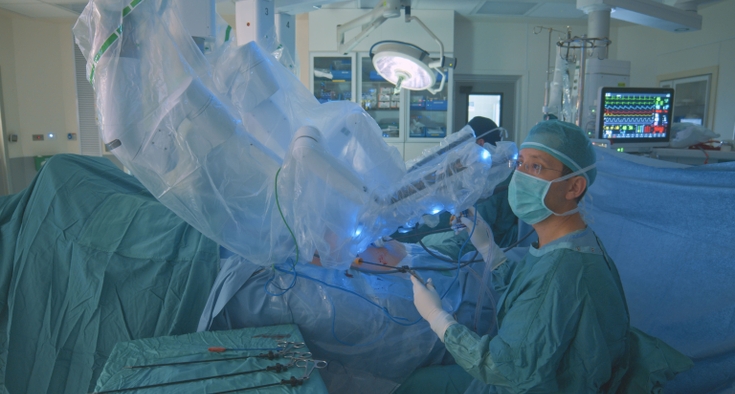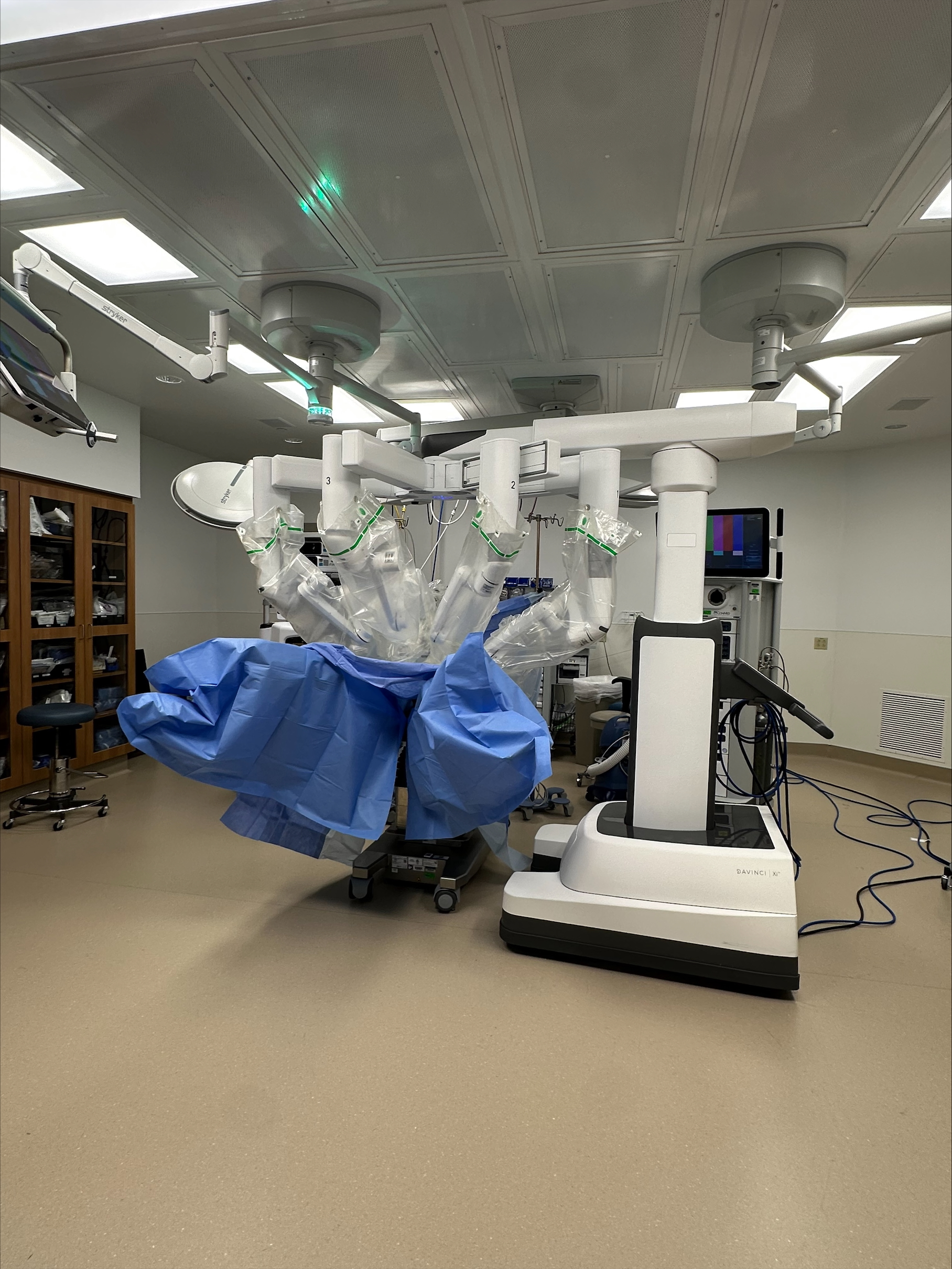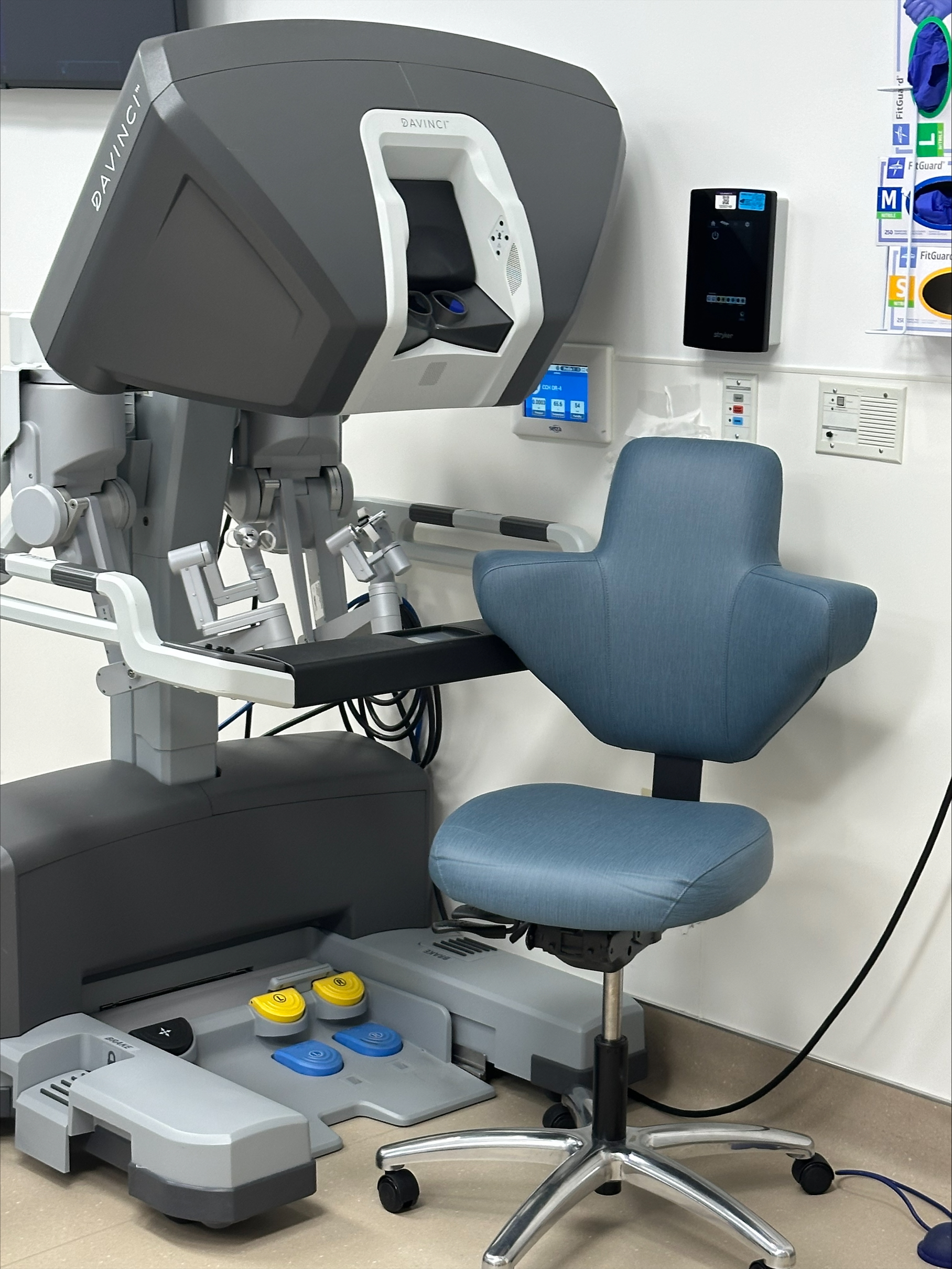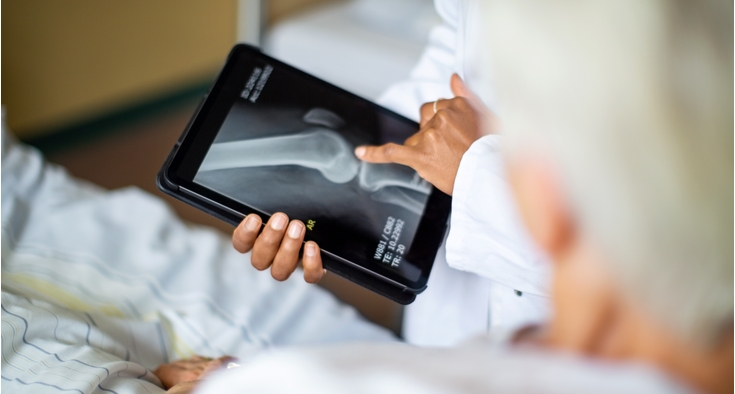You hear a lot about “robotic surgery” in healthcare today. But the phrase can be misleading if you’re not familiar with how robotic surgery is performed.
Despite what the name suggests, robots don’t perform surgery. Highly skilled surgeons use leading-edge technology and equipment to perform the procedure. They’re in total control of machines that we call robots. Importantly, these machines cannot do anything without the direction of the surgeon.
While robotic surgical systems have been around since the 1980s, they’ve become far more common in the past 20 years. They represent a shift toward “minimally invasive” surgery, which involves making far smaller incisions in patients than occurs with traditional “open” surgery.
During minimally invasive surgery, a camera is used inside the body to provide visualization, allowing the surgeon to accurately guide their tools. The advantages of minimally invasive surgery include less pain, faster recovery and return to daily routines, and smaller scars.
Here to explain is Dr. Steven Thies, of Southern Surgery Specialists - Hardeeville. He provides surgery at Novant Health Coastal Carolina Medical Center, where they recently received a prestigious designation for excellence in robotic surgery. See more on this in the sidebar below.
Nationally recognized surgical treatment close to home.
How were most of your procedures performed before robotic surgery became available?
Historically, all our operations in general surgery were performed with what is now called “open” surgery, using large incisions. These large incisions provided excellent exposure and great results, but large incisions are painful, slow the recovery process and are prone to developing hernias. In the 1990s, there was a revolution in surgery. Many commonly performed procedures migrated to a minimally invasive approach using laparoscopy.
Laparoscopy accesses the abdominal cavity through tiny incisions. The abdomen is inflated with carbon dioxide to create space that allows surgeons to pass a camera and special instruments through the tiny incisions and perform a variety of operations with great precision. This approach became the new standard for many operations. Laparoscopic approaches reduce pain, shorten hospital stays and reduce risks of wound infection and hernias.
Robotic surgery is an extension of laparoscopy. A robotic procedure begins like a laparoscopic operation. I place ports through small incisions and inflate the abdomen, but these ports are then “docked” or attached to the arms of the surgical robot. I then leave the operating room table and sit at an adjacent console.
There, I have a highly magnified, 3D view inside the patient’s abdomen. My hands control the instruments that are attached to the robotic arms, so I am in complete control at all times. The advantage of robotics over standard laparoscopy is the sophistication of the instrumentation.
These highly flexible tools allow me to operate as though my hands are actually inside the patient, executing complex movements that would be impossible with standard laparoscopic instruments. So robotic surgery offers great advantages for a variety of procedures, but it has not replaced laparoscopy for every procedure. Surgeons can achieve excellent results with either approach.
And while robotic surgery has become more common, it is important to remember that not every patient is a candidate for minimally invasive surgery, plus not every hospital has the resources for these costly systems.
Is robotic surgery only used in general surgery, or are we starting to see it in other specialties?
Robotics has become common in a number of surgical specialties. The pioneers in robotic surgery were the urologists who began doing prostate surgery some 15 to 20 years ago. As the robotic systems have become more complex, more specialties have adopted robotic approaches.
In general surgery, robotic options have exploded over the past five to 10 years. During that time, we have seen a shift toward robotic approaches for even some of the most complex general surgery cases.
At Novant Health Coastal Carolina Medical Center, we have two daVinci robotic systems, which is very unusual for a hospital of our size. We are very proud of our technology, which allows our gynecologists, urologists and general surgeons great access to precise surgical options.
This dedication to robotics has already benefited thousands of patients. Novant Health also recently invested in a Mako robot at Coastal Carolina that allows our orthopedic surgeons to provide hip and knee patients with a near-perfect fit for their new joints.
What does the robotic system look like and what are its components?
The robotic system consists of three components.
● Patient-side cart: This is the machine with the robotic arms and what people think of when they say “surgical robot.” The arms attach to the ports I described earlier. Once the camera and instruments are introduced, the surgeon's movements are translated by the robot into movement inside the patient. This part of the system cannot function independently, and all movement is frozen when the surgeon is not creating movements.
● Surgeon console: This is where the surgeon sits, and “sees” inside the patient with a highly magnified 3D optics system. The surgeon has full control of the camera and all instruments at all times, using hand controls and a variety of foot pedals.
● Vision cart: This is the computer brain of the entire system, governing the software, electrical, optics and communications systems of every component. Every movement and countless details of every procedure are recorded and analyzed.
What extra training do you need to perform robotic surgery?
Surgical residents are now getting robotic experience as part of their training, so it won’t be considered “extra” for them. They will enter practice with robotics already part of their skill set.
For most practicing surgeons, adopting robotic surgery requires lots of extra time, training, thought and commitment. With time and experience, this approach becomes second nature, and your robotic skills just continue to expand. It does seem that for those with extensive experience in minimally invasive surgery, this transition can be a little easier.
Surgeons often love robotics because of the benefits it offers their patients, but also because sitting to do a long, complex operation is a much better experience than standing. It’s much better to go home after a full day in the OR without a sore neck or stiff back that can accompany a long day of open or laparoscopic surgery.
Can you explain how robotic surgery potentially makes the patient's journey easier and smoother?
Our robotics systems are loaded with safety features, and our team maintains a great safety culture at all times. We believe robotics provides our patients with great outcomes in a safe environment, surrounded by caring people.
Robotic surgery provides much added value, but it is important to remember nothing we do in the OR has been replaced by the robot. Not the surgeon, not the surgeon’s knowledge and experience, not the anesthesia expertise, and not the caring manner of the entire surgical team. These critical components are preserved and emphasized. Robotics simply enhances patient care by leveraging technology to offer a faster and more comfortable recovery.
Preparation for your operation is the same for robotic procedures as for any operation. You will have a preoperative evaluation to review options and recommendations and to understand the risks and benefits. You will come to the hospital on the day of surgery, where you will meet your nursing team and anesthesia providers.
Your surgeon will meet with you just prior to surgery to answer questions and review the plan for the day. The surgery is done in the OR, where you’ll undergo anesthesia and the operation, and then move to the recovery room. In recovery, you’ll wake up with small incisions sealed with a thin layer of skin glue. Most outpatients are ready to go home an hour or so after their operation. Many patients require little to no prescription pain medication during their recovery.
Novant Health Coastal Carolina named Center for Excellence in Robotic Surgery
The hospital was officially named a Center for Excellence in Robotic Surgery by the SRC on May 8, 2025. It is the first hospital in South Carolina to receive this accreditation.
“This milestone places Novant Health Coastal Carolina Medical Center among an elite group of hospitals around the world recognized by SRC (the Surgical Review Corporation),” Dr. Steven Thies, general surgeon at Southern Surgery Specialists, said.
The designation reflects a four-year commitment by the hospital’s surgical team and leadership to meet SRC’s rigorous standards for surgical quality, patient safety and outcomes. SRC is an independent, nonprofit organization that has been protecting patients and promoting excellence in surgical care for more than two decades.
According to the SRC, designees who follow their proven methodologies consistently increase the number of patients they are able to treat while improving patient safety and experience.
For the team at Novant Health Coastal Carolina Medical Center, it’s a mark of pride to have years of hard work pay off. They’ve been committed to excellence in robotic surgery for years, and receiving this designation was a formal recognition of that. Now, patients from nearby no longer need to travel long distances to find world-class surgeons. They’re available right here at home.
Are there situations where a robotic approach to surgery is not advised?
Patients who have had numerous previous abdominal operations sometime form extensive scarring, or adhesions, that may make a minimally invasive approach difficult, but every situation is different, and these decisions are made on an individual basis.
On rare occasions, a patient may voice reluctance about having a robot involved in their surgical care. After a thorough explanation of what robotic surgery is and is not, most choose to proceed with a robotic operation. But for anyone still reluctant, an open or laparoscopic approach is always available and can be a good alternative.
Does insurance cover robotic surgery?
I have yet to encounter a case where insurance has refused coverage of a robotic procedure. So, at this point in time, the benefits outweigh the cost if you have insurance.
As with all technologies, the costs of robotic surgery should continue to decline over time as it becomes more widely adopted. Insurance companies understand that increases in surgical costs are significantly offset by savings generated from shorter hospital stays.
What questions would a patient want to ask their doctor if they’re considering robotic surgery?
Most patients want to understand how the robot works alongside the surgeon in the OR. After gaining some insight into the operative process, the remaining questions are very similar for patients having robotic, laparoscopic or open surgery.
With any procedure, I encourage patients to be open about their concerns and bring a list of their questions to their surgical appointment. I recommend asking about your expected recovery time, any postoperative restrictions, anesthesia methods, and how the team is prepared to respond if complications occur during surgery.
Most importantly, make sure your questions are answered to your satisfaction and that you feel comfortable with your plan of care and those who will be caring for you. Like any medical appointment, make sure you understand what you’re hearing and don’t be shy about asking your doctor to explain again.
Does robotic surgery reduce the need for how many people are in an operating room?
Robotics requires a specially trained team, but it is similar in size and number for any sort of operation. In a robotic OR, you’ll typically see:
● Bedside assistant: A scrub technician who communicates directly with the surgeon during the case and performs important functions such as instrument exchanges and camera operations.
● Circulating nurse: This nurse is responsible for the patient’s entry and exit, as well as the needs of the surgical team during the operation.
● Nurse anesthetist: This nurse is specifically trained in the administration and management of anesthesia and works closely with the anesthesiologist.
● Anesthesiologist: This is a specialist trained in the administration and management of anesthesia.
And of course, the surgeon. Sometimes, there may be two assistants for more complex operations. But the structure of the OR team is essentially the same for robotics as it is for an open or laparoscopic operation.













